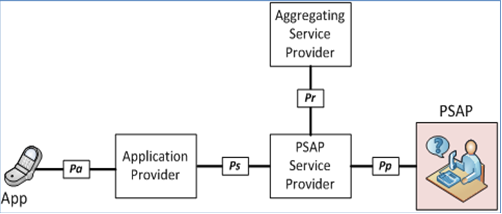PEMEA means Pan-European Mobile Emergency Application. The Pan-European stems from the necessity of enabling interoperable cross region and country emergency services. Mobile emergency applications provide high accuracy user location information to local emergency services, after an emergency call is made. Most of the times this emergency application due to their local profile, they don’t work when the user is away – abroad or out of region – from the area in which the application was designed to function.
PEMEA is an architecture that solves the problem of localized emergency applications by allowing mobile applications to provide accurate location and user information to the correct emergency answering point, irrespective of where the user has roamed to. Any mobile emergency application can use PEMEA to ensure that the user is found quickly.
The PEMEA architecture gives the emergency services a technological modernization as it expands the coverage that the answering centers can provide to the citizens, by implementing new necessary features. Furthermore, these features assure the coverage of some groups – for example, people with special needs – that were not covered before.
Connected to PEMEA network
On Going Deployment
App: Application that resides on the device, smartphone, tablet or laptop.
PSAP: Emergency answering point. The PSAP is able to use the information from the PEMEA message and associate with the emergency call. This provides the PSAP operator with accurate location information for the caller, as well as other information about the caller, including their name, what languages they speak and people to contact if the caller is in a bad way. The PSAP is able to use the information from the PEMEA message and associate with the emergency call.
Application Provider(AP): The role of the AP is to take the proprietary interface and data formats between the application and convert them to PEMEA messages. The AP may provide user information to any PEMEA-enabled PSAP or terminating-PSP with the PEMEA network, this information is controlled by the receiving PSAP and terminating-PSP processes and policies, and these should align with GDPR guidelines.
The PSAP service provider (PSP): is the gatekeeper between the PSAP and the PEMEA network. It has direct relationships with Application Providers that it trusts, other PSPs that it trusts and with special trusted routing nodes called aggregating service providers (ASPs) that can route PEMEA messages to PSPs in other regions and countries that the first PSP may not know about. The PSP is the first routing node in the PEMEA network, it looks at the location of the caller and determines if the information is a local PSAP or not, if it is not then it will pass it on to either another PSP or to an ASP depending on configuration.
The aggregating service provider (ASP): can be thought of as the “PEMEA street directory”, it knows about other ASP and PSPs and what regions they server, and is responsible for sending PEMEA data messages to these nodes so that the user data ends up at the same PSAP that the call does.

